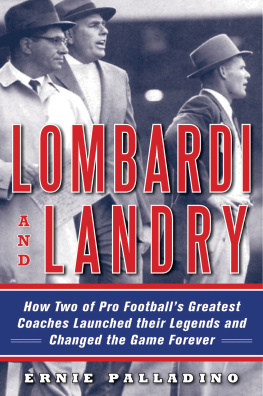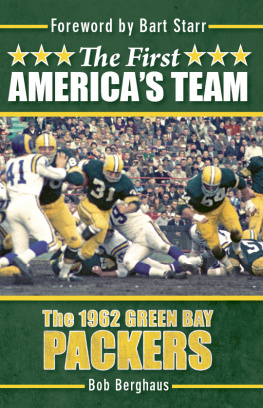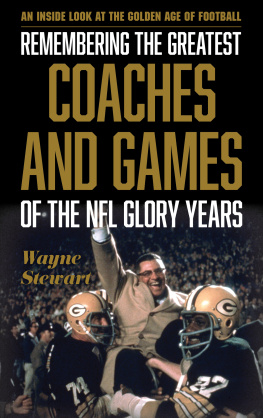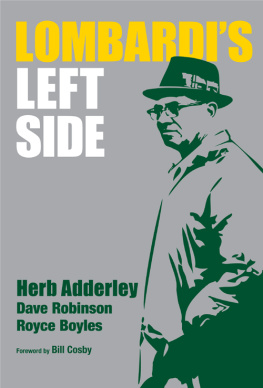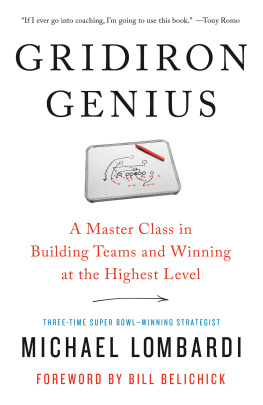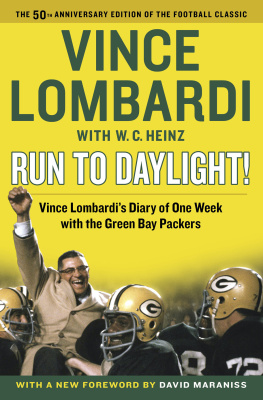LOMBARDI
A
N
D
LANDRY
LOMBARDI
A
N
D
LANDRY
How Two of Pro Football's Greatest
Coaches Launched Their Legends and
Changed the Game Forever
ERNIE PALLADINO

Copyright 2011 by Ernie Palladino
All Rights Reserved. No part of this book may be reproduced in any manner without the express written consent of the publisher, except in the case of brief excerpts in critical reviews or articles. All inquiries should be addressed to Skyhorse Publishing, 307 West 36th Street, 11th Floor, New York, NY 10018.
Skyhorse Publishing books may be purchased in bulk at special discounts for sales promotion, corporate gifts, fund-raising, or educational purposes. Special editions can also be created to specifications. For details, contact the Special Sales Department, Skyhorse Publishing, 307 West 36th Street, 11th Floor, New York, NY 10018 or info@skyhorsepublishing.com .
Skyhorse and Skyhorse Publishing are registered trademarks of Skyhorse Publishing, Inc., a Delaware corporation.
www.skyhorsepublishing.com
10 9 8 7 6 5 4 3 2 1
Library of Congress Cataloging-in-Publication Data is available on file.
ISBN: 978-1-61608-441-7
Printed in the United States of America
A la famiglia
Sempre Famiglia
CONTENTS
PROLOGUE
E VERYBODY STARTS someplace.
Even the greatest generals were, at one time, someone else's right hand. Sherman served Grant, MacArthur served Pershing, Eisenhower served MacArthur. They all had their beginnings answering to somebody else.
So it was with Vince Lombardi and Tom Landry. Just as none of history's stars arrived on the scene as full-blown leaders, two of the NFL's greatest coaches also had to serve their professional apprenticeships somewhere, under someone. Theirs came with the New York Giants under Jim Lee Howell. The lessons Lombardi and Landry learned between 1954, the duo's first year together, and 1959, Landry's final year in New York, carried them both into historic head coaching careers in Green Bay and Dallas. The responsibilities they held molded them into true leaders of men. The professional and personal setbacks and challenges each man faced steeled them for the adversity they would later encounter as head coaches.
They came to their respective success through hard work and God-given mental acuity. But there was a bit of luck involved, too. Had they worked under a boss other than Howell, who delegated responsibility to them on a level never seen before and rarely seen since, only smaller worlds might ever have heard the names Lombardi and Landry. Lombardi's legend might have been swallowed up by the vast landscape of college football or the small private sphere of banking; Landry's in the oil business. A few hundred people might have remembered them as astute givers of loans or as innovative oil rig designers. But Howell's managerial style allowed them to ascend to a much larger stage, where millions could appreciate the yield of their efforts weekly.
One remains a constant presence in the Super Bowl trophy that bears his name; the other set the standard for long-term coaching success in the modern era, and neither would have had the opportunity to make their mark if not for Howell's faith in them, and for their ability to fulfill Howell's sole commandwin.
He left Lombardi and Landry to take care of strokes both broad and minute, and they each delivered masterpieces.
The idea for this book sprang from a 2010 magazine article I did on the Giants great defensive lieutenants. The progression to head coaching success and, sometimes, greatness, was much the same for Bill Parcells, who served as Ray Perkins defensive coordinator in the early eighties, Bill Belichick, whom Parcells later molded after being promoted, and John Fox, who led the Giants defense under head coach Jim Fassel from 19972001.
This is the story of the professional beginnings of two of the greatest generals in NFL history. Their apprenticeships came at a time when being a pro football assistant was a part-time job done with full-time effort, when the sport itself completed the transition from a grungy, tramp-player Wild West show trying to horn in on college football's Broadway, to autumn's true national pastime.
The era, head coach, and lady luck all combined to make Vince Lombardi and Tom Landry who they were, and who they would eventually become.
None of it would have happened if not for the events of 1953.
INTRODUCTION
F IRING STEVE OWEN was the toughest thing Jack Mara ever had to do. He loved the old man. How could he not? Owen had steered the New York Giants through the last twenty-three years, won them 153 games, taken them to eight NFL championship games, and won two titles including the fabled Sneakers Game against the Chicago Bears in 1934. The whole Mara family admired everything about the man who had served the team's founding father, Tim, and his two sons, Jack and Wellington, since he came onboard in 1926 as a bruising two-way tackle, one year into the franchise's existence.
By 1953 it was time to go, though. Things had changed, speeded up both socially and competitively from the era the fifty-five-year-old Owen had known. The game was quickly moving from the straight-ahead, head-busting, territorial ground battle Owen prospered in as player and coach to a complex contest of speed, maneuverability, deception, and scoring. The game had passed him by, many in the press asserted. He was stubborn and slow to change, the critics said, and they were not wrong. While the rest of the NFL probed the perimeters of formations for opportunities, Owen's philosophical compass still pointed north and south on both offense and defense.
Despite the criticism, nobody really blamed Owen for his inability to adapt. North-South was what he knew, what his game had been for so long. As a player in 1927, he had stood strong in a sixty-minute fistfight against Red Grange and the Bears. The 137 win in late November, combined with a 140 win over the New York Yankees the following week gave the Giants a first-place finish. In the young NFL, there were no championship playoffs. Finishing on top of the regular-season standings was as good as it got. The Chicago game sealed Owen's reputation as a give-no-quarter, ask-no-quarter player. Playing next to Cal Hubbard on the defensive line, the future Hall of Fame duo held off the Bears with a ferocious goal line stand to maintain a 77 tie that eventually allowed the offense to convert a fake punt and the 58-yard completion which came off it into the winning touchdown.
Owen and his offensive counterpart Jim McMillen, who later gained fame as a popular pro wrestler, sat exhausted in the dirt for more than five minutes after that game, barely able to muster enough energy to shake each other's hands. It was the toughest, roughest football game I ever played in, Owen recalled years later.
That bloodbath sat long in the tobacco-chewing, gravel-voiced coach's past by the end of 1953, though. America and its National Football League were on the move. The three-year, undeclared war in Korea had wound to an uneasy conclusion. Dwight Eisenhower had taken over at 1600 Pennsylvania Ave. at the dawn of an era where nothing happened, unless one counts the escalation of the cold war, the horrific aftermath of McCarthyism, racial unrest, and the rise of the Brooklyn Dodgers to World Series champions. The women of the country had started doing their laundry in new time-saving electric washing machines and their cooking on electric stoves. Ribbons of asphalt spread like tentacles across the nation, and people used the fast-developing interstate highway system to heed Dinah Shore's urgings to See the USA in your Chevrolet. And none of the wise-ass athletes who came out of college ogling Marilyn Monroe or the vets who survived bloody front lines from Okinawa to Inchon had much patience for loudmouth Depression-era guys like Owen telling them what to do and how to do it.
Next page
